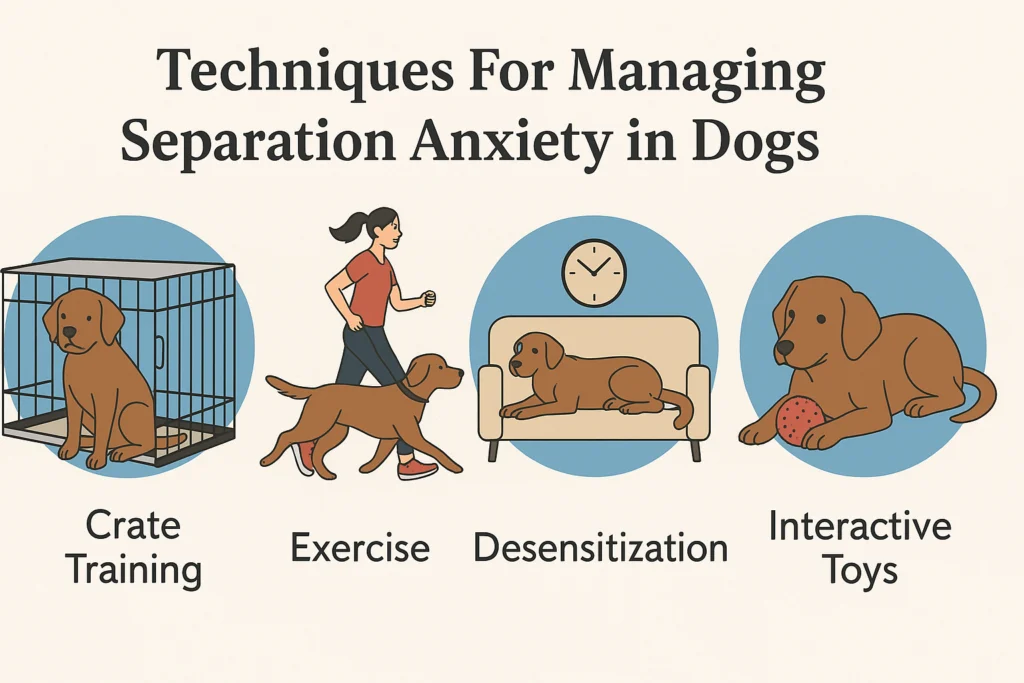Separation anxiety in dogs is a distressing condition where a dog experiences excessive stress and behavioral problems when left alone or separated from their primary caregiver. Unlike a bit of whining or barking when you step out, true separation anxiety can lead to destructive behavior, escape attempts, and even self-harm. It’s a psychological condition that’s deeply rooted in the dog’s bond with its owner, often reflecting the pet’s emotional dependence and fear of abandonment.
This condition isn’t limited to a specific breed, age, or size—any dog can develop separation anxiety under the right (or wrong) circumstances. It often emerges after a major change, like a move, the loss of a family member, or even a shift in routine like an owner going back to work after a long period at home.
In essence, it’s not your dog being “bad” or “spoiled”—they’re genuinely scared and confused. And while it’s heartbreaking to witness, the good news is that it’s manageable with patience, consistency, and the right approach.
Techniques For Managing Separation Anxiety in Dogs
Starting Young: Socialization and Crate Training
The best defense is a good offense—and when it comes to separation anxiety, prevention starts in puppyhood. Socialization and crate training play a huge role in helping dogs feel safe, confident, and independent.
Socialization Tips:
- Introduce your puppy to different people, sounds, and environments during their critical development phase (3–14 weeks old)
- Allow them to have supervised time away from you, gradually increasing the length and variety of settings
- Expose them to other dogs to promote healthy interactions and reduce dependency on humans
Crate Training Benefits:
- A properly introduced crate becomes a safe haven, not a cage
- Crates mimic a den-like environment that provides comfort and structure
- Gradually extending crate time teaches self-soothing and reduces panic
Starting early doesn’t guarantee your dog won’t experience anxiety, but it drastically reduces the likelihood. It’s all about teaching them that being alone doesn’t mean being unsafe.
Establishing a Safe and Comfortable Space
One of the easiest ways to ease your dog’s anxiety is by creating a designated comfort zone. This isn’t just a cozy spot—it’s a sanctuary that reinforces feelings of security and routine.
Elements of a Comfort Zone:
- Comfortable Bedding: A plush bed or soft crate mat that smells like you can be reassuring
- Favorite Toys: Chew toys, plushies, or puzzle games keep your dog entertained and focused
- Limited Access: Use baby gates or pens to confine your dog to a smaller area
- White Noise: Calming sounds can reduce outside triggers
Make this area consistent. The more your dog associates this space with calm and comfort, the more it will serve as their safe retreat when you’re away.
The Role of Routine and Consistency
Dogs are creatures of habit. They thrive on routine, and disruptions often lead to anxiety. Creating a predictable daily schedule helps your dog anticipate what’s coming and reduces fear of the unknown.
Tips for Building a Solid Routine:
- Consistent Meal Times: Serve meals at the same time each day
- Regular Walks and Playtime: Physical activity helps reduce nervous energy
- Scheduled Alone Time: Practice leaving your dog alone during predictable times
- Departure Cues: Keep arrivals/departures low-key to minimize emotional spikes
When your dog knows what to expect, they feel more in control—and that sense of control is critical for reducing anxiety.
Gradual Desensitization Strategies
Gradual desensitization is one of the most effective techniques for tackling separation anxiety. It’s all about slowly exposing your dog to the act of being alone in a way that builds confidence instead of fear. Think of it like easing into cold water—step by step, rather than jumping in.
Here’s how to get started:
- Practice Short Absences: Begin by leaving the room for just a few seconds. Return before your dog has the chance to panic. Gradually increase the duration as your dog grows more comfortable.
- Simulate Departures: Pick up your keys, put on your shoes, or grab your bag—but don’t actually leave. These actions are known as departure cues and can trigger anxiety. Doing them without leaving teaches your dog not to associate them with fear.
- Monitor Behavior Closely: Use a pet camera to observe when and how your dog reacts. This can help you identify thresholds and adjust your approach.
- Daily Practice: Consistency is crucial. Work on desensitization exercises daily and always end on a positive note.
It’s not a quick fix—it can take weeks or even months—but it lays the foundation for long-term calm and independence.
Counterconditioning Approaches
Counterconditioning is a technique where you change your dog’s emotional response to being alone from negative to positive. Instead of dreading your departure, your dog begins to associate it with something enjoyable.
How to Use Counterconditioning:
- High-Value Treats: Give your dog a long-lasting treat, like a frozen Kong filled with peanut butter or treats, right before you leave. Make it something they only get when you’re gone.
- Pair Departures with Fun: Start short absences and immediately reward them with praise and play when you return, gradually teaching them that being alone leads to good things.
- Interactive Toys: Puzzle feeders or slow-dispensing toys that engage their brain can redirect focus and ease nervous energy.
When used alongside desensitization, counterconditioning becomes even more powerful. It not only reduces anxiety but helps build positive associations that rewire your dog’s brain over time.
Using Positive Reinforcement Effectively
Dogs learn best through positive reinforcement—it’s simple psychology. Reward the behavior you want to see more of, and ignore or redirect the behaviors you don’t.
Examples of Positive Reinforcement in Separation Training:
- Calm Behavior: If your dog stays relaxed when you walk toward the door, reward them with a treat and calm praise.
- Independence: When your dog voluntarily goes to their bed or crate, reinforce that action.
- Quiet Time: Use treats or toys to reinforce quiet time in their comfort zone.
What to Avoid:
- Never punish your dog for destructive behavior resulting from anxiety—it’ll only increase their stress.
- Avoid scolding upon returning home. It teaches them that your return is associated with tension and fear.
Positive reinforcement strengthens your bond with your dog, builds trust, and reinforces the idea that being alone is a normal, even enjoyable part of life.
Environmental Enrichment Techniques
Keeping your dog’s brain busy while you’re away is a powerful way to ease separation anxiety. Think of it as giving them a job to do—something that captures their attention and rewards them.
Top Toy Choices:
- Puzzle Feeders: Require dogs to figure out how to get food out of a toy. These are mentally stimulating and satisfying.
- Treat-Dispensing Balls: Roll them around, and treats fall out. It keeps dogs engaged and physically active.
- Durable Chew Toys: Relieve anxiety through oral stimulation and can occupy dogs for long periods.
Rotation is Key: Don’t leave all the toys out at once. Rotate them to keep things fresh and exciting. Introducing a “new” toy every couple of days keeps your dog’s curiosity alive.
By focusing on enrichment, you transform alone time from a scary event into an opportunity for play and discovery.
Background Noise and Calming Sounds
Silence can be unsettling for anxious dogs. A quiet home amplifies every creak, bark from outside, or car passing by. Adding soft background noise creates a calming atmosphere and masks outside triggers.
Best Options for Calming Sounds:
- Classical Music: Research shows that classical music can reduce stress levels in dogs.
- White Noise Machines: Mimic the constant hum of human presence and block distracting noises.
- Dog-Calming Playlists: Apps and streaming platforms offer dog-specific calming tracks designed to soothe and relax.
Consider pairing sound therapy with pheromone diffusers or calming sprays to boost the effect. Over time, your dog will associate these sounds with safety and comfort.
Interactive Devices and Treat Dispensers
Technology can be a game-changer in managing separation anxiety. From remote treat dispensers to pet cameras with two-way audio, today’s gadgets help bridge the distance between you and your dog.
Popular Tools:
- Pet Cameras: Let you watch, talk to, and even toss treats to your dog from your phone. Great for reassurance and monitoring progress.
- Automatic Treat Dispensers: Drop treats at scheduled intervals to break up the time and reward calm behavior.
- Voice Recorders: Some devices let you record comforting messages for your dog to hear throughout the day.
Used wisely, these tools can reduce feelings of loneliness and help reinforce training. Just be careful not to overuse them—your dog still needs to learn to self-soothe without constant interaction.
Causes of Separation Anxiety in Dogs
Understanding the root causes of separation anxiety is key to addressing it effectively. Here are some of the most common triggers:
- Sudden Changes in Routine: Dogs thrive on consistency. If your work schedule shifts drastically or you start leaving the house more often, your dog might struggle to adapt.
- Past Trauma or Abandonment: Rescue dogs or those who have spent time in shelters are particularly vulnerable, especially if they’ve experienced abandonment in the past.
- Lack of Socialization: Puppies that aren’t exposed to different people, environments, and experiences during their critical development stages may develop anxiety issues.
- Over-Attachment: While bonding is essential, dogs that are overly dependent on their owners are more likely to panic when left alone.
- Changes in Household: The addition or loss of a family member—be it another pet or a human—can unsettle a dog emotionally.
How to Identify the Signs and Symptoms
Recognizing the signs of separation anxiety early can make all the difference. These symptoms often show up shortly after you leave and may escalate over time. Here are the most common indicators:
- Destructive Behavior: Chewing furniture, scratching doors, or tearing pillows are common acts of frustration and fear.
- Excessive Barking: Dogs may cry, bark, or whine for long periods once their owner leaves.
- Pacing and Restlessness: Some dogs walk in circles near doors and windows.
- Inappropriate Elimination: Urinating inside despite being house-trained is a clear stress response.
- Escape Attempts: Dogs may try to dig under fences or break through doors.
- Excessive Drooling or Panting: Even in cool rooms, dogs may drool excessively from anxiety.
Every dog expresses anxiety differently. Some become lethargic, while others are visibly frantic. If these behaviors occur regularly when alone, it’s time to take action.
The Impact of Separation Anxiety on Dogs and Owners
Separation anxiety doesn’t just cause temporary distress; it affects your dog’s well-being:
- Chronic Stress: Weakens the immune system and increases illness risk.
- Depression: Loss of interest in play or food.
- Increased Aggression: Fear may escalate to aggression toward pets or people.
- Development of Other Phobias: Often leads to noise phobias or fear of strangers.
Dogs are sensitive, and long-term stress changes their brain chemistry. Early intervention is critical for their quality of life.
Challenges Faced by Dog Owners
Dealing with separation anxiety can be draining:
- Property Damage: Torn blinds, chewed shoes, and destroyed furniture add up.
- Neighbor Complaints: Nonstop barking strains relationships.
- Limited Social Life: Owners may avoid leaving their dog, leading to isolation.
- Emotional Toll: Causes guilt, helplessness, and frustration.
This creates a cycle—your stress fuels their anxiety. A solid plan and support network are essential.
The Importance of Early Intervention
Early action provides significant benefits:
- Faster Training Results: Young or newly anxious dogs respond quicker to behavior modification.
- Stronger Bond: Working through anxiety builds trust.
- Cost Savings: Avoids expensive repairs or medical treatment.
If you notice even mild symptoms, take proactive steps to prevent months of frustration.
When to Seek a Dog Trainer or Behaviorist
Sometimes, no matter how much effort you put in, you may feel like you’re hitting a wall. That’s when a professional dog trainer or certified behaviorist can make all the difference.
Signs You Need Help:
- Your dog shows signs of panic even after consistent training efforts.
- You’re worried about your dog’s safety or well-being.
- Destructive or aggressive behavior is escalating.
A professional brings experience, objectivity, and a toolkit of proven methods tailored to your dog’s unique situation. They can also guide you through complex techniques like systematic desensitization with better structure.
Veterinary Support and Medications
For severe cases of separation anxiety, medical intervention may be necessary. Anxiety, just like in humans, can be a chemical imbalance in the brain.
Common Options Include:
- Anti-Anxiety Medications: Such as fluoxetine (Prozac) or clomipramine, prescribed by your vet.
- Supplements: Like L-theanine, CBD oil (vet-approved), or calming chews.
- Pheromone Therapy: Adaptil collars or sprays mimic natural calming scents.
Medication isn’t a crutch—it’s a tool. Often, it’s used temporarily to stabilize your dog so that behavior modification training becomes more effective.
Exploring Dog Daycare and Pet Sitting Services
For dogs that struggle the most when alone, dog daycare or hiring a pet sitter can be a short-term or even long-term solution.
Benefits Include:
- Socialization: Daily interaction with other dogs and humans.
- Exercise and Stimulation: Physical and mental activity that keeps your dog tired and content.
- Peace of Mind: Knowing your dog isn’t alone and distressed while you’re away.
Even a few days a week at daycare or a midday visit from a sitter can drastically reduce stress and aid in long-term anxiety reduction strategies.
Tools and Products to Help with Separation Anxiety
Anxiety Wraps and Calming Collars
Anxiety wraps and calming collars are simple yet highly effective tools designed to soothe your dog through gentle pressure and calming scents. These products can work wonders when used alongside behavioral training and enrichment strategies.
Anxiety Wraps (e.g., ThunderShirt):
- How They Work: These wraps apply gentle, constant pressure to your dog’s torso, much like swaddling a baby. The sensation has a calming effect on the nervous system.
- When to Use: Ideal for high-anxiety moments such as just before leaving the house or during storms and fireworks.
- Tips for Success: Introduce it during calm times first so your dog doesn’t associate it solely with stressful events.
Calming Collars:
- What They Do: Infused with pheromones or essential oils like lavender or chamomile, these collars release calming scents that help reduce stress.
- Best For: Dogs that respond well to scent-based relaxation. They’re easy to use and non-intrusive.
- Duration: Most last 30 days and can be worn with a regular collar.
While these aren’t miracle cures, they’re helpful additions to a holistic treatment plan and often provide comfort during critical training periods.
Smart Cameras and Remote Interaction Tools
Technology now gives us the power to interact with our pets, even when we’re miles away. Smart cameras with two-way audio and treat dispensing capabilities are more than just gadgets—they’re lifelines for anxious dogs.
Top Features to Look For:
- Two-Way Audio: Talk to your dog and offer comforting words when needed.
- Motion Alerts: Know when your dog is pacing, barking, or moving excessively.
- Treat Dispenser: Reinforce good behavior remotely with tasty rewards.
- Night Vision: For those long nights or winter months.
Popular Devices:
- Furbo Dog Camera
- Petcube Bites
- Wyze Cam (budget option)
These tools give you real-time insight into your dog’s behavior and allow you to provide comfort, correction, or praise at the right moment—without being physically present.
Natural Remedies and Supplements
For pet parents who prefer holistic approaches, natural remedies can offer mild to moderate relief for dogs with separation anxiety. While not all work for every dog, they’re worth exploring with your vet’s guidance.
Natural Calming Aids:
- CBD Oil: Derived from hemp, CBD can reduce anxiety and promote relaxation. Use only products specifically designed for dogs and approved by your vet.
- L-Theanine & L-Tryptophan: These amino acids promote serotonin production and have calming effects.
- Herbal Blends: Chamomile, valerian root, and passionflower are often used in calming chews and sprays.
- Pheromone Diffusers (like Adaptil): Emit a synthetic version of the soothing scent mother dogs produce for puppies.
Important Tips:
- Always check with your vet before starting any supplement.
- Monitor your dog’s behavior closely to ensure there are no adverse reactions.
- Use these in conjunction with—not instead of—training.
Natural aids are not cures, but they can offer a layer of comfort that supports the overall anxiety management plan.
Common Mistakes to Avoid
Punishing Your Dog for Anxiety
One of the most damaging reactions to separation anxiety is punishment. Unfortunately, many owners, out of frustration, scold or discipline their dogs for destructive or disruptive behavior.
Why It Backfires:
- Your dog isn’t acting out of defiance—they’re acting out of panic. Punishment only increases fear and stress.
- It damages trust. Dogs begin to fear your return, associating it with anger instead of comfort.
- It can escalate the anxiety, making behaviors worse over time.
What to Do Instead:
- Redirect destructive energy with toys or enrichment.
- Reinforce calm behavior with treats and praise.
- Address the root cause with training, not correction.
Your dog needs your support, not your anger. Compassionate, consistent handling is key to healing.
Inconsistency in Training and Routine
Dogs crave predictability. If your training efforts are sporadic or your daily routines are inconsistent, it can confuse your dog and delay progress.
Common Pitfalls:
- Practicing training exercises only once in a while.
- Constantly changing walk or feeding times.
- Inconsistent reactions to anxious behavior (comforting one day, scolding the next).
How to Stay Consistent:
- Set and stick to a daily schedule.
- Involve all family members so responses are uniform.
- Track progress and setbacks to refine your approach.
Consistency isn’t just helpful—it’s essential. Dogs learn through repetition, and routine helps them feel secure and confident.
Ignoring the Problem or Delaying Action
Some pet owners hope their dog’s anxiety will resolve on its own or dismiss early signs as “just a phase.” But ignoring the problem often allows it to grow into a much more serious issue.
What Happens When You Wait:
- Anxiety intensifies and becomes harder to treat.
- Your dog may develop additional behavioral problems.
- Emotional stress for both pet and owner multiplies.
Why Prompt Action Matters:
- Early intervention leads to quicker, more lasting results.
- It spares your dog unnecessary suffering.
- You avoid damage to property, relationships, and your own mental health.
When it comes to separation anxiety, time is a critical factor. The sooner you take steps, the better the outcome for everyone involved.
Interview with a Professional Dog Trainer
Trainer: Sarah Kim, CPDT-KA
“Separation anxiety is one of the most emotionally draining conditions for dog owners. But it’s treatable. My biggest tip? Never go faster than your dog’s pace. Build confidence slowly and consistently. Don’t focus on what they can’t do—celebrate every little win.”
Sarah emphasizes the importance of positive reinforcement, patience, and a community of support. Many of her clients have seen complete turnarounds with the right blend of compassion and structure.
Reader-Submitted Tips and Experiences
- Mark from Arizona: “Doggy daycare 3 times a week was a game-changer. It gave Bella the stimulation she needed and gave me peace of mind.”
- Joanna from Toronto: “The Furbo camera let me talk to my dog mid-day. Just hearing my voice kept her calm.”
- Alex and Jamie, NYC: “We used a white noise machine and an Adaptil collar—after a month, no more barking fits when we left.”
These stories show that while every dog is different, support and persistence go a long way.
FAQs
Can separation anxiety go away on its own?
No. Without intervention, it usually worsens over time. Training and behavioral support are essential.
How long does it take to fix separation anxiety in dogs?
It varies. Some dogs improve in weeks, while others take months. Consistency and early action make a huge difference.
Is it okay to get a second dog to help with anxiety?
Sometimes, but not always. A second dog may help if your dog is social, but it won’t replace training or fix the root issue.
Are certain breeds more prone to separation anxiety?
Yes. Breeds like Labrador Retrievers, Border Collies, and German Shepherds are known to form strong bonds and may be more prone.
Should I ignore my dog when I leave and return home?
Yes, keep departures and arrivals low-key. This helps reduce the emotional spike associated with your comings and goings.










![Can Dogs Eat Blood? 7 Side Effects [Expert Opinion]](https://petskor.com/wp-content/uploads/2022/04/Webp.net-resizeimage-12.jpg)
